Last Updated on September 21, 2019 by Steve Hogg
Before reading this post, it is advisable to read Get a Grip in the Articles section for background as to choice of bar shape.
Okay, I hope by now that you’ve been interested enough to have read enough of this site to have your cleat position, foot correction, seat height and seat setback some where in the vicinity of where they need to be. Assuming that’s the case, where to put the bars and at what height to place the brake levers on those bars?
This post will be an attempt to advise on those matters. I’ll start with handlebars first and then progress to brake hoods. For the purposes of explanation I will assume that our hypothetical subject has an ideal seat position, cleat position and an ideal degree and placement of foot correction. With that proviso, the bars need to be placed so that the rider can exercise all of their hand placement options comfortably. The drops, bar tops and brake hoods should all be accessible with ease and without causing more than a minor shift in position of body on seat. Before continuing, a short digression. Comfort on a bike is necessary for optimal sustained performance for a whole host of reasons. Comfort however, has to be measured against duration of effort. A rider who is completely comfortable for a 1 hour local crit, may not be comfortable with the same bar height on a 5 hour training ride. You need to be comfortable for the use you put your bike to and for the time period you plan to do it. The parameters that allow that are:-
1. Bar width
Grab a pair of bars, stand in front of a mirror, place your hands in the drops and hold them in front of you with arms slightly extended while taking care to ensure that your shoulders are not thrust forward and that your elbows aren’t locked. The correct bar width for road riding is when you look at your reflection and see that the the centre of your fists are slightly wider apart than your shoulder centres as viewed from the front. Most riders can go up a size in width without discomfort with the only penalty being that they will be more of a wind sock than necessary. Going down a size rarely causes a problem in a physical sense but there is a trade off in stability and breathing efficiency at some level. This is far worse for some than others so to be safe, use the correct width bar rather than one that is too narrow.
2. Bar height
A proportion of riders rarely use their drop bars because they can’t comfortably reach them. In any bunch you will see some bikes with brake hoods and the bar tape on the top of the bars showing signs of use. But on the drops, the tape will be pristine or nearly so. There is no point if having drop bars if they can’t be reached comfortably. The key determinant of bar height is the range of motion of the riders neck. The rider needs to be able to look ahead comfortably using no more than 85 – 90% of their ability to extend the neck.
When next you are riding, whether indoors or outdoors, place your hands in the drops and look comfortably ahead. Looking through your eyebrows a bit is okay providing you can clearly see ahead. From that head carriage position, try and lift your chin in an arc by extending your neck. Take care that your elbows don’t straighten, this is a head movement only. You should have a reasonable range of motion still left when riding in the drops. If you don’t, during sustained efforts, you will either look up only occasionally and risk hitting whatever is in your path OR you will tighten muscles of the neck, shoulders and upper back which not only can be uncomfortable, but because of reciprocal inhibition, can diminish performance and reduce effective lung capacity to individually varying degrees. 3 examples of the range of neck movement that is desirable for riding in the drops follow. The first is a club racer, the second a woman on the Singaporean national squad and the third, an elite junior triathlete.
The amount time you spend on a bike plays a part in this. If you feel you can reach the drops with ease, great. As a test, ride in the drops for the last 30 minutes of a 4 hour ride. If you can’t perform that task with ease, then your bars are probably still a bit low. Unless of course, you never ride for 4 hours at a time! Comfort is a relative thing. If your regular longest ride is say, 2 hours, then the position that allows relative comfort will be somewhat different to what would be required for 6 hour rides.
Signs that your reach down to the bars is too great can be –
- Pressure / pain just behind the scrotum (males) or on external genitalia (females)
- Upper neck and upper back tension or pain during or after a ride
- Low back pain during or after a ride
- Any increase in on seat instability
- A reluctance to ride with hands placed in the drops after several hours riding.
- Hand numbness or soreness.
- Pain in front of the hip from cramped (and probably already too tight) hip flexors.
Many of these examples can have other causes but if you cannot ride in the drops for a substantial time (relative to the time you spend on a bike) then you should ask yourself why. I’m not suggesting that you have to ride in the drops. I am suggesting that the option should be available to you, comfortably.
3. Reach to the bars
The ideal reach to the bars is when your shoulders are relaxed and not thrust forward and your elbows are relaxed with no sense of tension in the muscles of the upper back and shoulders. Under load, everyone shortens their position to some degree. If your position is good, this ‘shortening’ will be minimal. Early warning signs of too far a reach to the bars can be -.
- Sliding forward on the seat under load
- Thrusting the shoulders forward and extending the arms or arching the back to greater degree
- General feeling of instability on the bike.
- Sore hands, neck or shoulders on long descents.
The pic below is instructive. This is an elite woman under a reasonably serious load on the trainer. Basically she’s at TT effort intensity. She is functional enough to relax as you can see, but she wouldn’t be able to look this relaxed without an ideal reach to the bars. In hindsight, I wish I’d asked her to stop looking at her power output and to to look ahead instead; but you will get the idea.
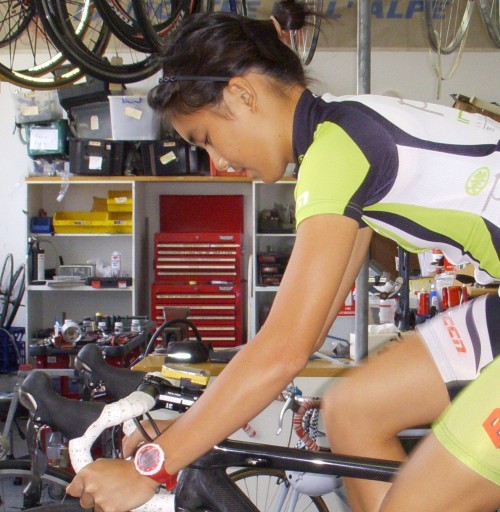
Here’s another example; in this case an old bloke who rides occasionally riding at TT pace.
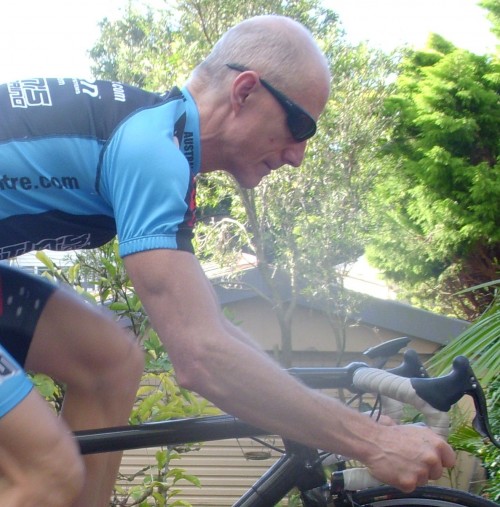
As you can see; elbows are bent and shoulders are not thrust forward or raised. The basic message I’m attempting to get across is that reaching any point on the bars should be easy. Easy when you are cruising and still easy when you are hammering.
4. Bar angle
The angle of the bars should allow you to ride in the drops with unbent wrists, other than when you reach for the brakes. Doing so is much more comfortable than riding for extended periods with bent wrists. Bar choice plays a large part in this too, not just the angle of the bar. This article goes into more detail about bar shape and design.
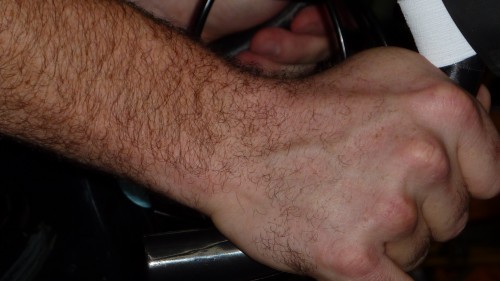
At the same time, you should be able to reach the brakes with ease.
5. Brake hood height
I would like to say that an ideal brake hood height will allow you to reach the brake hoods with unbent wrists as per the pic below but the situation isn’t as clear cut as that. Some combinations of rider proportion and function (which affects the angle that their arms reach to the brake hoods) and bar and brake hood shape mean that when brake hood height
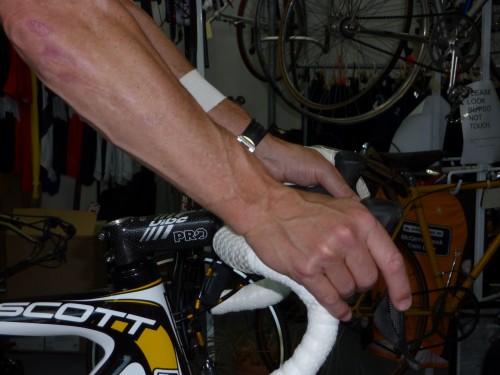
allows unbent wrists, brake hood height may be a touch too high for climbing with hands on hood while off the seat at the same time. In cases like this a compromise is needed; a brake hood height that is a touch low for perfect comfort when riding on the seat and close to perfect when climbing off the seat. If bar choice is careful, this compromise may not be necessary but sometimes, it is not possible to avoid. When this happens the rider must decide what is the more important issue for them. Perfect on the seat comfort on the brake hoods or perfect off the seat climbing comfort on the brake hoods. Neither is wrong, it is more a matter of personal priorities.
For general guidance, if the rider feels more pressure on the heel of their hand than they they do in the webbing between thumb and index finger, then the hoods are too low. If there is more pressure felt in the webbing between thumb and forefinger than there is on the heel of the hand, then the hoods are too high. When the pressure between the heel of the hand and webbing between thumb and forefinger is even, then the hood position is good. This is not a fail safe ‘rule’ but a general recommendation that will keep most people happy with the occasional exception.
6. Reaching the brake levers from the drops
Brakes aren’t a lot of use unless the rider can reach them. This isn’t always as easy as it should be, because Sram and Di2 apart, road brake levers are not as adjustable for reach as they need to be to allow wide variety of hand morphology that the cycling population displays reach the brake levers comfortably. I get a little frustrated by this when I have fit clients with short fingers. Both Shimano and Campag have shims to allow reach adjustment but it is not enough for a sizable minority of cyclists. If you are one of the riders affected by this, the most effective compromise is as follows.
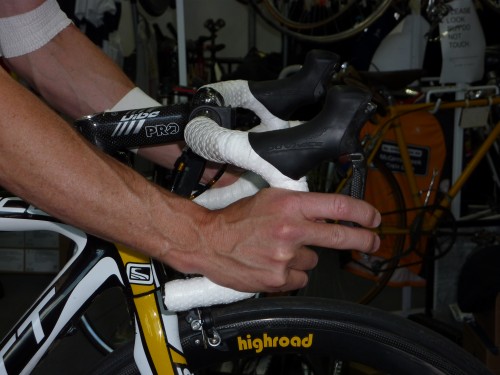
Current brakes from Shimano, Campagnolo and Sram are more powerful than what was available in days of yore. So the “short fingered solution” is to have the brake calipers more open than is the norm. Then choose the bar shape that allows the brake hoods to be at a good height and the reach to the brakes to be such that the rider can place a finger tip on them. Then adjust the brake calipers to be more open than ‘normal’. That means that by the time that the rider pulls on the lever and the brake pads contact the rim, they have at least one full joint of their index and middle fingers engaged fully with the brake levers allowing good grip and leverage.
So that’s about it. Unless of course your name is Oliver Torkel and you aren’t happy with the choice of bars available. In Oliver’s case, he decided to make his own. See below.
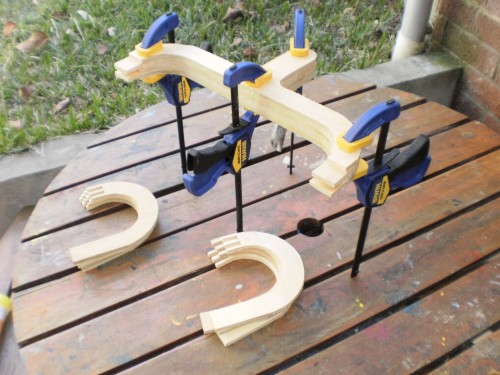
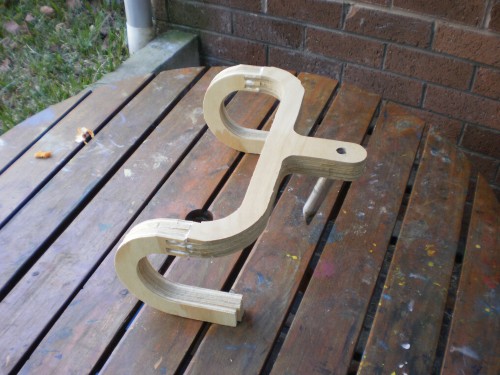
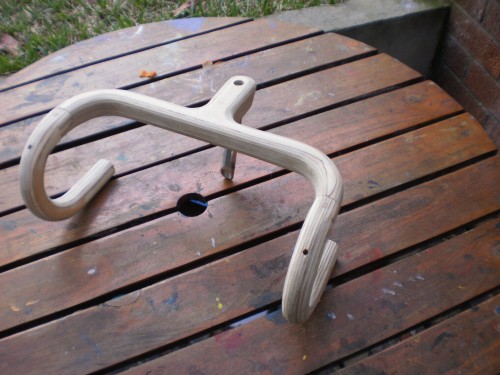
Note: Often, more specific answers to your questions can be found in the Comments below or in the eBooks section and FAQ page.
To learn more about bike fit products offered by Steve, click here.
Do you have a bike fit success story? Please go here to share.
Thank you for reading, return to the Blog page here or please comment below.Comments (56)
Comments are closed.

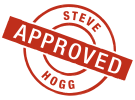
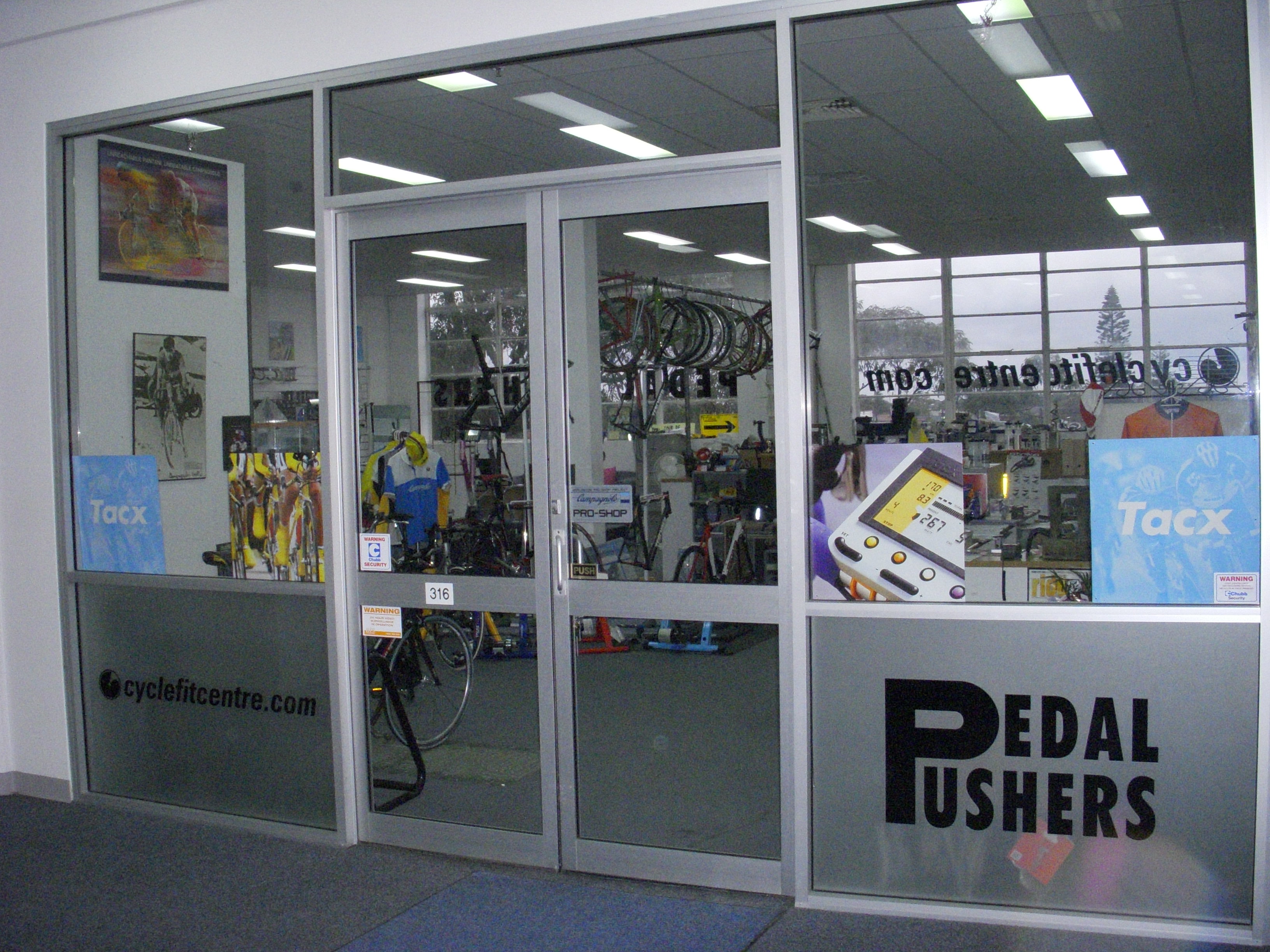

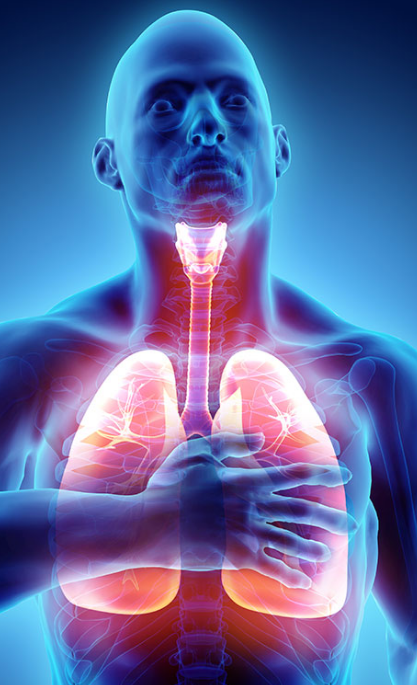
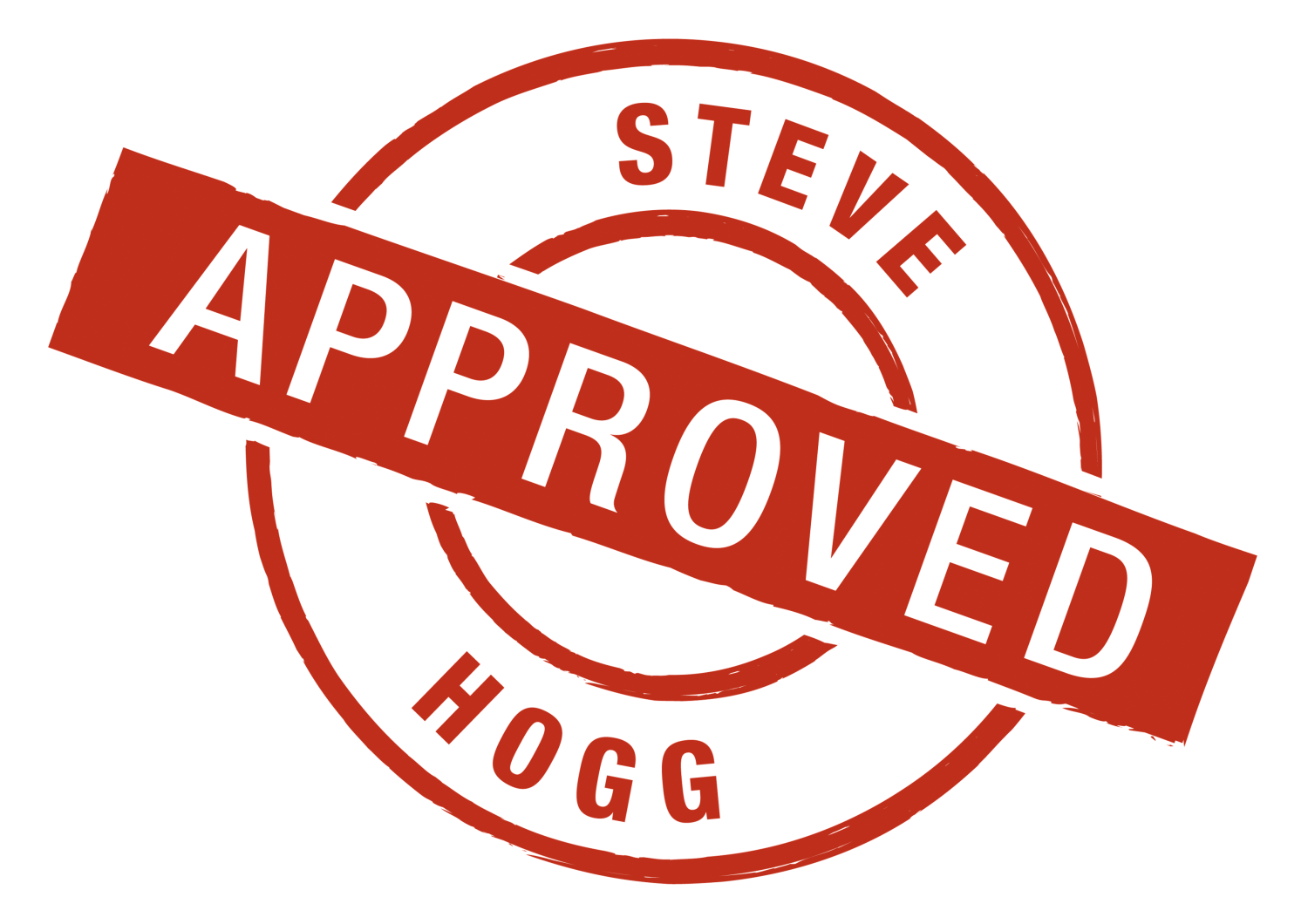

It seems the young lady is a lot more relaxed than the old bloke. Please explain
I think the differences you perceive are down to the old bloke’s greater muscularity and lower body fat, not in ability to relax.
Steve
As I have played with adjusting my reach to the bars I have noticed a difference in reach that varies with the amount of anterior pelvic rotation. The different degrees of rotation also seem to effect where I am generating power from. More rotation more power is gluteal based. Is it a matter of comfort or is there some advantages to riding with the pelvis rotated forward ? Is there an optimal angle.
Thanks
Bill
G’day Bill,
The ideal degree of anterior rotation of the pelvis is that
which you can maintain under high load. If it is an effort to maintain, you
won’t be able to to it when the going gets tough.
Is there an optimum angle?
Flatter is better with the proviso above observed. In any individual case,
yes, comfort is the best guide.
Hi Steve,
Have you noticed many problems with printings/markings on parts when it comes to bike set-up? I have 2 sets of Pro Vibe 7s bars. One set is fine, but on the other, the printing of the logo is not centred. I set up a new bike recently, was doing some measurements, and found by accident that I’d been riding with the bars pushed to one side for about 2 years!
I also have 2 Selle Italia SLR Gel Flow saddles. One is a year or 2 older but looks exactly the same.. except the scale and limit marks on the rails are in a totally different place. Possibly made differently, but I reckon it’s more likely that the markings are just printed in random positions. Something to watch out for!
Cam
G’day Cam,
Yes, I see the same things from time to time. It is always worth a check by measuring from the centre of the faceplate of the stem to either side of the bar. Re what you’ve observed with seats, yes, not uncommon at all. Sometimes it is the result of a change in production location or refinement of design based on rail failures and so on. For instance, a lot of current Selle Italia seats have the limit marks on the seat rail 40 – 45mm apart. Considering that many seat posts have a seat rail clamp that is 40mm long from front to rear, this means that effectively there is zero or very little ability to adjust seat setback without moving outside the limit marks. If you don’t understand how a manufacturer can design a product like a seat that effectively allows negligible adjustment, well neither do I. My assumption, which I cannot verify is that there were some rail failures so the answer was to bring the limit marks on the seat rail closer together, rather than strengthen the seat rails.
Hi Steve,
Not sure if this question fits in here, but I will give it a go. I just replaced my old shimano 6600 ultegra shift levers with the new 6700 ultegra levers and it seems there is a definate difference in the platform length of the two models. My reach feels lower and longer as compared to the previous model (set with in the same place). Do you know this to be true and what the actual difference is between the two? Have you had clients make this switch and have to use a shorter reach bar or stem? Also, can you share which hoods are shorter or longer when comparing the main contenders (Sram, Campy, Shimano). Thanks for offering much great information to the bike world.
Tim Holder
G’day Tim,
You’ve caught me out! I’ve never measured them because I approach tasks like this individually for each client. That is I position what ever brake levers the rider has for them, I don’t have any rule of thumb recommendations other than:
The rider should be able to reach the hoods with unbent wrist and without shoulders thrust forward.
Concurrent with that, the rider should be able to reach the brake levers with enough purchase to use them safely without contorting their wrists to do so.
When you say that you positioned them in the same place, does that relate to hood placement or where the clamp on the handlebar is?
I would start from scratch and position them as per above; unbent wrists and being able to reach the brakes. If you find these two things mutually incompatible, please get back to me.
Hey Steve,
If I set my bar/hoods so that my wrist are straight as pictured above then in both positions the overall reach and/or drop is to long/low (ie. LB, HS, crotch, and hip strain) with my current bar and stem set-up. I have shortened the reach by rotating the bars up so the tops are flat and mounted the hoods higher. This is pretty comfortable, but my wrist are cocked up in all positions and lever reach is difficult in the drops. To achieve the positions pictured above I would have to shorten the stem or the bars. I would rather not shorten the stem because the top of the bars would be unusable which leaves me with a shorter reach bar, I assume? I am currently using a bontrager race x lite VR bar which is suppose to have a 85mm reach (my measurement is 90mm). I love the round shape of the bar and would like to find a shorter bar with a similar curve. I tried the PRO Vibe compact and the PLT both are suppose to be 78-79mm. I would have thought this would have been a good reach, but both are way to short. Do all the bar companies measure reach C-C ? Am I on track with my thinking on the need for a shorter bar and do you have any recommendations? Sorry for the lon question.
Tim
G’day Tim,
I’m at a bit of a loss. As I write this, I don’t have a 6700 and 6600 lever to compare. However, I would have thought that the 6700’s had a shorter reach on the grip section of the brake hood than the 6600. Putting that aside, you have a problem. If you tilt the bars up to bring the hoods back, the grip section of the bar becomes more vertical. That causes 3 problems.
Firstly, it means that the hand has to assume a more vertical orientation when in the drops. This drags the elbow down and causes more extension of the torso. If the rider can’t do that comfortably, they will thrust the shoulders forward which in turn potentially loads up the neck.
Secondly, it makes the brake levers harder to reach as you say. And thirdly, is is not possible to sprint well with that more vertical hand orientation which causes the rider to move their hands more rearwards, which lessens ability to reach the levers to change gears.
The Bontrager VR’s are a decent bar for right person and application. As I said, I’m surprised that you are having problems, but as you are, 2 solutions that come to mind are:
Change your bars to Deda RHM 02’s. They are a very similar shape to the Bontrager VR’s but have a 75mm reach. If this is too short, then you may be able to find a happy medium by lengthening your stem 10mm as well. Be aware that Deda measure bars outside to outside (I’m not sure whether Bontrager measure outside to outside or centre to centre).
Better still would be to change to a 3T Ergonova or FSA Wing Compact. The shape of the drops of both is cunning. It is less round than the VR’s or RHM’s but allows a good grip angle of the hand in the drop while still allowing good access to the brake lever while in the drops. They are 8mm shorter and 5mm shorter respectively in the reach. The other option is 3T Ergosum. They have a reach of 89mm nominally but in practice the LTD and Team are 89mm (carbon) and the Pro is more like 80mm (aluminium).
I can’t help but think it is not the levers that are the problem but where they are placed. Have you tried using the shim that Shimano make to shorten the reach to the brake levers from the drops?
If not, it comes in 2 versions. One that shortens the reach by 5mm and the other by 10mm.
Steve,
Thanks for the analysis! You have convinced me that the hoods are not the problem, but rather the placement of the hoods and the overall reach. I will try the the options you have offered and am sure things will work out.
Okay Tim,
I’ll wait to hear from you.
Hi Steve, I hope this is best place for my handle-bar height question.
I am trying to duplicate the handle-bar height between my 2007 Time Edge with Time forks that you cycle-fitted in May 2008 and my 2010 Baum Ti with WoundUp road forks. Assume the seat and seat height is same on both bikes and set-back is also nearly same.
Is it just a matter of putting two bikes next to each other and making them straight and level and then note the top of handle-bar height differences or does the bottom-bracket height and other factors such as fork lengths etc come into play? Many thanks!
G’day Yuri,
the method you mention will only work providing:
1. You can get both bikes dead upright and level, which is a harder task than you might expect
2. That both frames have the same bottom bracket drop below the axle line.
I would suggest that you lock the bike that you are using as the control up in an indoor trainer and use a long carpenter’s level to make sure that it is levelled between axle centres. Then measure your seat height and setback by any method you choose. Then use the long level to measure the drop between seat and bar. In the near future there will be a detailed post on a repeatable measurement method. Also an article coming out in BA soon about the same.
thanks Steve. Followed your instructions. Measured Time Edge that you positioned in 2008 and arrived at 25mm saddle to bar drop. Then measured Baum and (surprise!) only found it to be level, i.e. 0mm saddle to bar drop. So 20-25mm higher handlebars on new bike. This may explain why the drops are (almost) more comfortable than the brake hoods. But what I can’t explain is why riding on brake hoods after 3.5-4 hours feels like there is a fraction too much weight on hands/arms/upper-back…. The stem length is same for both bikes, 100mm. I thought higher hars should make all positions easier to hold…. Bizarre.
G’day Yuri,
If you are too squashed up, and it sounds like you are, a 25mm increase in bar height equals an 8mm shorter reach. That can load up the arms and shoulder complex because you are not as stable as if your back extension was ideal. On your new Baum, duplicate the position I gave you in ’08.
Steve,
Would sore/pain in the extensor spinae be more of an indication of a reach that is too short or too low? Should I just go by trial and error by reducing one or the other and see how it goes?
G’day Marc,
Correct. It could be either. It depends on whether the pain
is because the neck is too extended (bars too low and / or too far away) or not extended enough (stem too short and / or bars too low).
When you move to the drops, is there any increase in perineal pressure?
If so, that is the first sign that the bars are too low; assuming of course that the seat and cleat positions are good.
There is not perineal pressure, but I did just change my saddle position tilt down by 1 or 2 degrees. Before I had it set at nose up 5 degrees and now it is nose up 1 to 2 degrees. Could the extensor spinae pain be from the slight change in saddle position? Today when in the drops there was no sensation to slide forward and no pain in the perineal.
Marc
G’day Marc,
It is possible though unlikely that the change in angle of
seat triggered the problem. Nose up 5 degrees will cause too much lumbar flexion in just about any seat I have seen.
Steve,
How do you go about measuring the tilt of a saddle…some fitters believe in putting a straight edge or flat piece of wood on saddle and then put the level on top of that and others believe in just putting the level on the middle of the saddle…please let me know, as it can cause a few degree difference.
G’day Marc,
Lock the bike up in a trainer and use a long carpenter’s
level to make sure that the bike is levelled between axle centres. This essential, otherwise anything that follows is not accurate. Don’t lean the bike against a wall; don’t get anyone to hold it ‘upright’, don’t guess when it is level in the trainer; lock it up in a trainer and use a long level to ensure that the bike is genuinely level.
Then place your flat piece of timber or sheet of metal on top of the seat and use a digital level on top of that.
I seem to be reaching by about 40mm to rest my hands on hoods, My stem is 110 , should I replace with a shorter stem?
G’day Domavery,
I assume you mean over reaching by 40mm to the brake
hoods. You’ve given me bare bones info but if you are trying to reduce your reach by 40mm you only have 4 options.
1. Reduce stem length
2. Raise brake hoods further up on the bar
3. Replace your bar with one with a shorter reach
4. Raise the height of your bar.
Or any combination of those. You want to end up in a position that allows you to reach the brake hoods, bar tops and drops with ease and that can be sustained for reasonable periods at intensity.
Hey Steve, you’re quite right Sorry,question was not that well stated. Im sitting ok just bihind the crank, and thats ok for me, my problem is that to reach the hoods relaxed my arms are locked and I feel that my weight is more forward than it should be,I drops back a little off the hood and im comfortable about 40mm back off the hoods. The image above shows wrists straight ,as mine are when placed back on the hoods, I have a Madone H1 but my stearer is uncut, I cant rasied the bars any higher as I have no length left and Trek states that I need at least 5mm spacer above the stem. My stem is 110, hence my original question, over reaching by about 30-40mm. I could install a shorter stem? would this hinder performance ? Regards Dom
G’day Domavery,
Are you also over reaching when you place your hands in the drops?
While on that subject, can you ride comfortably with hands placed in drops for lengthy periods?
Hi Steve, Its a slight over reach i guess, I can manage about 30mins cruise in the drops, then my lower back starts to get sore. so about 8-10 miles tops.
G’day Domavery,
the reason I ask is that I’m trying to work out how much of your problem is bar height, not bar reach. Firstly, I would suggest flipping the stem to the high position (if you haven’t done so already). That will give you an extra 18 – 12mm in height for your 110mm stem and it will also shorten your reach by 6 -7mm.
Then reassess your reach issue and shorten your stem accordingly. Once you can reach the brake hoods comfortably, reassess your reach to the bars. I don’t know how much you ride, but assuming the rest of your position is okay, you should be able to ride for a sustained period in the drops without discomfort. If the reach to the hoods is fine (once you’ve shortened the stem) but the reach down to the drops is not, then start thinking of fitting a plus 17 degree stem which will give you another height rise again.
The simplest short cut is to find a decent bike shop with good stock of stems, fit your bike on an indoor trainer and give yourself a work out with different stem lengths and angles of rise. It shouldn’t be too hard to work out what feels good and then confirm or otherwise with a test ride outdoors.
G’day Steve,
Thought id give you an update, I have changed stem to a 90mm one and this has made a huge difference, its surprising what 20mm does, also with the old 110mm the bike was slow to react , im running Aeolus 5.0 wheelset and the side wind was a worry sometimes,with the new 90mm stem its no longer a problem, not really noticing any side wind at all, The bike is a lot more responsive. Many thanks for your input , Problem resolved!
G’day Domavery,
I’m really happy for you that you worked it out and got
a positive result. Best of luck.
Steve,
In your article “Get A Grip” what are some examples of Bar #5? (Manufacturer brands, etc.) Thanks
G’day Marc,
There are a number of shallow drop, short reach bars out
there that are good. All have their pros and cons but the ones I use a lot in fitting or recommend to clients are:
FSA Wing Compact
3T Ergonova
3T Ergosum
ITM Alutech Wing
Deda RHM
Deda Zero 100 Compact
And other similar bars from a range of manufacturers and bike brands.
Steve,
Is the relationship between saddle height and bar height treated independently of each other? For example, if there was an increase in saddle height would this also call for an increase in bar height to keep the the relationship the same? I am assuming the answer is, yes, in order to keep all the angles the same.
G’day Craig,
Generally the answer is yes unless the seat height increases because of significant in function and flexibility over time. If that’s the case, then each needs re evalutating separately.
Steve,
How should one go about setting up 3T ergonova handlebars as far as the rotation of the bar? In terms of the bar tops, should the bar be flat? When this is don’t the drops seem to be rotated to vertically, which you say is bad. But then when the drops are rotated the tops of the bars angle down almost like a classic bar or rotunda? Please let me know, as I saw you said these are good bars. Thanks.
G’day Craig,
Firstly, the bike needs to be levelled between axle centres
using a long carpenter’s level while locked up in a trainer. Leaning against a wall is just inaccurate. Fit the bar without tape on and using a digital level placed at the rearmost underside of the drop of the bar, a typical angle should be 5 – 10 degrees up towards the front. Most are in the range of 5 – 8 but trial and error will sort that you out in an individual sense.
Steve,
When in the drops my hip angle and diaphragm feels cramped so I raised my bars up 5mm and just was out for a recovery ride (so did not ride under load) but it felt better already. In trying to avoid the bike fit from hell, I was wondering if changing just the bar height is reasonable? What I mean is, do I have do adjust anything else to compensate for the change in bar height, i.e., saddle height because the a higher bar would cause one to sit further back or is just a bar height change ok? Thanks
G’day Sapal,
You’re doing fine. Read the post on How To Avoid Bike Fit Hell again and follow that advice as it is tried and true over many years.
You’ve made one change, it seems positive, so stick with it for several weeks and then reassess. Don’t convince yourself that because you have changed one parameter of position, that you NECESSARILY have to then make a cascade of others.
Steve,
Thanks. I did my normal Tuesday intervals so was able to ride under some high loads and I definitely felt more powerful throughout the entire pedal stroke, especially over the top (I believe this is from my hip angle opening up with the increase in bar height). Also, I have the sensation that I sit a few mm back (which is actually more comfortable) because before I was sliding forward on the nose of the saddle which is a clear indication of the bars being too low. I think I need to reassess the rotation of the bar slightly but I will stick with it for now. Thanks for the awesome blog.
G’day Sapal,
Stick with it, as everything you say is positive.
OK will do,
What does the effect of raising the bar have on the bar reach? Is it 1:1, as in 5mm increase would equal 5mm shorter as well? Thanks.
G’day Sapal,
typically it is one in 3. That is for every 3mm that the bar
comes up, the reach from nose of seat to bar reduces by 1mm. However as you say that you feel you are now sitting further back and more comfortably on the seat, I would suggest you not make any other changes other than the rise in bar height that you have just done until you spend a few weeks riding with that change only.
Thanks so much Steve,
I will let you know how it goes. A change such as this isn’t as drastic as other changes so it should be okay to continue riding hard and racing, as opposed to other times when you say “cruise post changes?”
Cheers
Let comfort be your guide. But yes, a minor change like a 5mm rise in bar height should take little or no time to be come accustomed to.
Steve,
It is amazing how many riders, myself included, let their ego get in the way thinking that a long/low set up is the way to go to be aero like the “pros”. But what is the point of being aero if it is going to cost you 35 watts anyways? Thanks
G’day Sapal,
You’re right and I see it all the time. The other thing is
that not all pros look long and low. Many are, many aren’t. As I say to clients “If you want to look (their conception) like a pro, you’ve got to be able to function like one”. That rules most people out! I ride long and low but have stretched regularly for years which means that I can do it comfortably.
Steve –
The blog is much appreciated, and has helped in re-discovering fluidity on the bike after some years of injury and such-like due to time off for school and lawyer exams.
My question is as follows and regards bar position – I feel quite comfy (upper body wise) holding onto the lever hoods when set up in the article above, and don’t feel like I have many issues. BUT: when I get into the drops, I feel all sorts of stretched out and uncomfortable. I can breath easily, and put the power down but feel like the drops almost want to wander underneath my hands. To counteract, I slide my hands forward into the curve, but then feel all stretched out. Yes, I duck my shoulders as well, and roll my lower back up and around correspondingly, but I end up doing that on the tops anyway when riding hard and it’s been that way for 20 years without a problem.
Thoughts?
Shorter stem? – and if shorter, do I then need to lower the bars to maintain the same drop.
Twist bars up?
Shut up and get used to it?
Data is as follows:
I’m running SRAM Red levers on a set of PRO Vibe 7S “round” bars. The levers are raised all the way to the top of the curve, and the bars are rotated forward to just north of flat -which puts my wrists straight when in the drops. Stem is 130mm 6/84d.
I’ve set my shoes (BONT A-One w/ shimano SPD DA 7900 pedals) up according – or as close as I have been able to – to your arch/canting/shimming/knee tracking instructions and those feel good (very good). Same with saddle height and set back. (using Fizik Antares)
I don’t feel the tendency to slide forward on the saddle while going hard.
Bike has been in a HOGG position for the past week. Shoulder/neck pain was not an issue when I first made these changes last Wednesday, but was after yesterday’s ride.
Gordon Daniell
Brooklyn, NY
USA
G’day Gordon,
This sounds to me like your bar position is not even close
to right. If moving your hands to the drops is a problem, then the position of the drops ( or possibly the seat, feet etc) is a problem. You need to be able to reach the drops and sustain effort comfortably.
Assuming the rest of your position is close to ideal; and maybe it is and maybe it isn’t, then the bars are too low or too far away, possibly both.
If you have an indoor trainer and a friendly bike shop that will loan you several stem lengths and rises, this should be easy to solve. Your guiding principle should be that you can exercise all your hand placement options; tops, hoods and drops, comfortably.
Hello Steve,
I have a tendency to sink my neck into my shoulders, or better I tend to lift my shoulders, if I do not concentrate on keeping my shoulders relaxed and down. What is it a symptom of? should I lower the bar or increase reach? I can pass the balance test and if I push hard on the pedals the problem dissapears.
Also i would like to know if there are any circumstances if you advise to place your seat further back than necessary to pass the balance test. I ride a lot, but I am not a racer and I am more concerned on comfort at medium to high intensities rather than maximum output. If I place the saddle slightly rear it would allow me to have less weight on the bars even at lower speeds. What disadvantages would that bring?
Thanks a lot for your help
Ranieri
G’day Ranieri,
You imply that there is too much weight on your hands but
you pass the balance test. That’s a bit odd in my experience. That leaves to options only.
1. That you are performing the balance test properly but have extremely poor general stability. That is ability to hold yourself. If so, that will be obvious off the bike in terms of poor posture.
OR
2. You are not performing the balance test correctly.
Now I don’t know which option is the most likely. I would suggest trying 3 things separately.
A. Recheck your cleat position. Cleat position can have a marked effect on stability on the bike.
B. Raise your bars and ride for a couple of week with them higher and see if that makes a positive difference.
C. Do as you suggest and move the seat back a touch further and ride for say 2 weeks like that and reasses.
Dear Steve,
I’m going through a bike of my own bike fitting difficulty and was wondering if you could give a tiny bit of insight. My knee’s and feet feel good/fine in terms of them not hurting or giving me any trouble. However, I feel like I am sort of slouching or rolling my shoulders forward a bit when riding. I feel like I’m hunching over a bit when I don’t actively think about keeping my back straight and my eyes/chest out and ahead.
Now this all ties back to reach/stem length in that I also feel like I am “reaching” a bit to the brake hoods. When I have my hands in the drops they feel much more comfortable and I’m not “reaching” anymore. I feel like my body is maybe a bit too far back from the hoods but the drops I can reach fine with a bit of an elbow bend.
I know this is quite a bit of info but just wanted to get your take on this. Thanks, your site has been very helpful in the past.
G’day Jorsabez,
Assuming that seat setback and seat height are okay,
everything you say suggests that you bend well at the hip (you reach the drops okay) but don’t extend your spine well (don’t reach the bar tops / brake hoods easily).
Long term the solution is to work on your ability to better extend your thoracic spine . Short term the solution is to reduce the need to extend it by raising your brake hoods if brake hood position is the major problem or by fitting a higher stem if the top of the bars is the problem.
If you raise your bars, you are looking for the greatest amount of thoracic extension that you can comfortably maintain. What that means is that as the bars come up, you may need to use a longer stem.
Dear Steve,
That suggestion/advice seems to be spot on. I actually stuck a few additional spacers under my stem and that made a noticeable difference in raising the bars up and making it easier/more comfortable to reach the hoods. However, now when I’m in the drops I feel like I’m loading my arms too much and they fatigue/tire/get sore very fast. They are bent quite a bit as if the bars are too close as if I need a longer stem(just like you said). I’m currently running a 100mm stem and have a 110 coming in the mail this week. I feel like with the 110mm I might be able to mess with it a bit and try to find a medium between the two *drops and hoods* that works for me…or at least makes both tolerable.
What you described above regarding the thoracic spine seems to be quite correct as well. I have no trouble bending at the hips and can easily touch the floor/toes without trouble. When I’m in the drops I feel no pressure and actually wouldn’t mind going lower expect for the bars being too close thing.
Do you have any suggestions regarding stretching or things I should work on regarding the thoracic spine to help better extend it and maybe improve this drops/hoods discrepancy I’m experiencing?
Also, thank you so much for that advice already, having an idea to build off of is so helpful. This site/blog has been quite the eye opener for me and extremely beneficial.
Thanks again!
G’day Jorsabez,
How to improve ability to extend thoracic spine. Here’s
a to do list.
1. Recognise that your limited ability to extend it is because of holding postures that flex it for lengthy periods. So stand TALL, sit TALL at your desk or when watching TV or other seated past times and repeatedly catch yourself. Good posture underpins good neural function and good athletic performance and yet most people have crap posture. Just stand and sit TALL 2. Any stretching exercise that causes you to extend your spine is a good one for you. So stretch it. Downward dogs, kneeling spine extensions with an exercise ball, lying across a roller or any similar exercise will help.
My favourite works quickly but is a bit hard core for some. Buy 2 tennis balls, put them in an old sock and tie the end of the sock into a knot so that the ball are forced together snugly. Place the sock/balls on the floor so that their long axis is 90 degrees to your spine. Lay with bare torso across the sock/balls so that the dorsal process of your vertebrae fit into the hollow between the balls. Place the sock/balls at the height of the lowest rib; i.e, the junction between T11 andT12, the lowest thoracic vertebra. Now do 5 partial situps over the sock /balls. Then move the sock/balls up one vertebra and repeat. Then move up one vertebra and repeat with each thoracic vertebra in turn all the say up. Do this 3 times per week. The localised stretching pressure caused by the sock/balls can be quite confronting for those not used to it but is unlikely to do any damage
providing;
a) you make sure that it is your thoracic spine only over the balls and
don’t attempt this with your cervical or lumbar vertebra
b) that you operate within normal discomfort tolerance limits.
Dear Steve,
Thanks again for the additional advice. I do believe that my posture it not nearly as good as it could be. I will make a conscious effort to improve that as well as give the tennis ball thing a shot.
Went out riding again today and my findings from the day prior were further confirmed. The hoods felt fine and comfortable while the drops were a pain due to my arms being quite bent. I felt like my weight was all being supported by my hands/arms and that my head was “out in front” of the bars. My center of gravity/weight basically felt too far forward compared to where the handlebars were, I wanted a longer stem.
Your advice already has been dead on and super helpful, it really makes me feel better to have an idea what to work on. Everything you said lines up perfectly and makes logical sense with what I have been feeling/experiencing. Thanks a bunch!
G’day Jorsabez,
I’m glad that you’re happy. When I advise people I
haven’t met and can’t see it feels like I am looking through thick fog or frosted glass. I’ve had a lot of practice but sometimes I wonder whether I’ve hit the mark in individual cases.